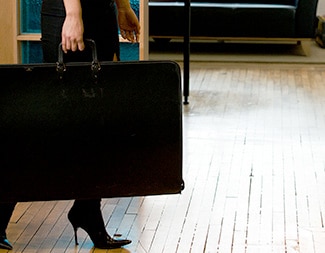
Planning ahead and using our interview tips can make employer interviews a breeze.
Design Career Guide
Interview Essentials
Even if you have the coolest site portfolio on the Web, many design jobs still require a live interview and a presentation to a client or potential employer. In it, you will showcase your portfolio, explain your creative process, and illustrate why you are the right designer for the job.
As you might already know, public speaking is one of the top fears for most of us. Don’t let this discourage you from making a great impression. Below are some interview tips adapted from our Design Business course by industry guru Daniel Schutzsmith.
1. DEFINE YOUR OBJECTIVES
A job interview is a question and answer session between you and a potential employer. A presentation is usually used in a freelance or potential client situation and is more of a one-way communication. In most interviews, you are looking to have your portfolio at hand to show at a moment’s notice.
Think about how and when you’d like the client/employer to look at your work. Bear in mind that the client is looking at your portfolio mostly from the perspective of finding the right person for their design project or position. Your goal is not to show every piece of work in your portfolio. Aim to engage the client in a discussion about their specific needs and then frame your work as a potential solution to the client’s problem.
2. FOCUS ON DELIVERY
Traditionally, designers presented their work using a portfolio book filled with printouts. This method is still a terrific way to show your capabilities because it gives the participants the chance to interact with you and with tangible materials. Passing around the printouts, explaining some of the key details in each project, and opening up the presentation to become more of a discussion will make everyone in the room feel like they are involved in something truly special.
Web design, multimedia, or animation employers will be expecting to see work that’s based on a presentation of work on-screen. Bear in mind that in many cases, they will have reviewed your site or demo reel in advance, and will have a list of specific questions for you to answer. In that case, you won’t be in the driver’s seat, but you will get the chance to discuss the intricate details of your work, which is good!
3. DON'T GET STUCK ON TECHNOLOGY
4. SALES SPEAK DOESN'T SELL
We all know when we are being sold to. Think of that feeling you get when you walk onto a car lot and the salesman starts to walk toward you. Most likely you’ll feel some anxiety. Perhaps you’ll try to avoid the salesman by looking in a different direction, and maybe you’ll even be rude and snap “just looking!” Now, imagine how your audience will feel if you start spouting how great your design skills are by badmouthing another design firm or talking over their heads. Chances are, they’re going to feel uncomfortable and not give you a call back.
Instead, make the interview a conversation about the client/employer’s goals. Research your questions for the interview, and bring a list.
5. RELAX
Forgetting about the stresses of life is essential when making a presentation. Try to block out what the rest of the day has thrown at you and just focus on the interview or presentation at hand.
Visualizing is an excellent way to clear your mind and give yourself some mental practice of how the presentation will go. Will the participants be smiling? Will they laugh at your jokes? Will they applaud at the end? Take a few minutes, close your eyes, and visualize how the presentation will play out in its entirety.
6. LEAVE SOMETHING BEHIND
No, we’re not saying you should leave your jacket so you have an excuse to go back! But since you are a designer, make sure you leave behind a summary of the presentation you gave and some other print collateral or goodies that the audience will get use out of. At the very least you should leave a business card, but here are some other ideas for things you can leave behind:
- Marketing packet with work samples
- Overview of your creative process
- Printouts of your work (especially a piece they liked)





















